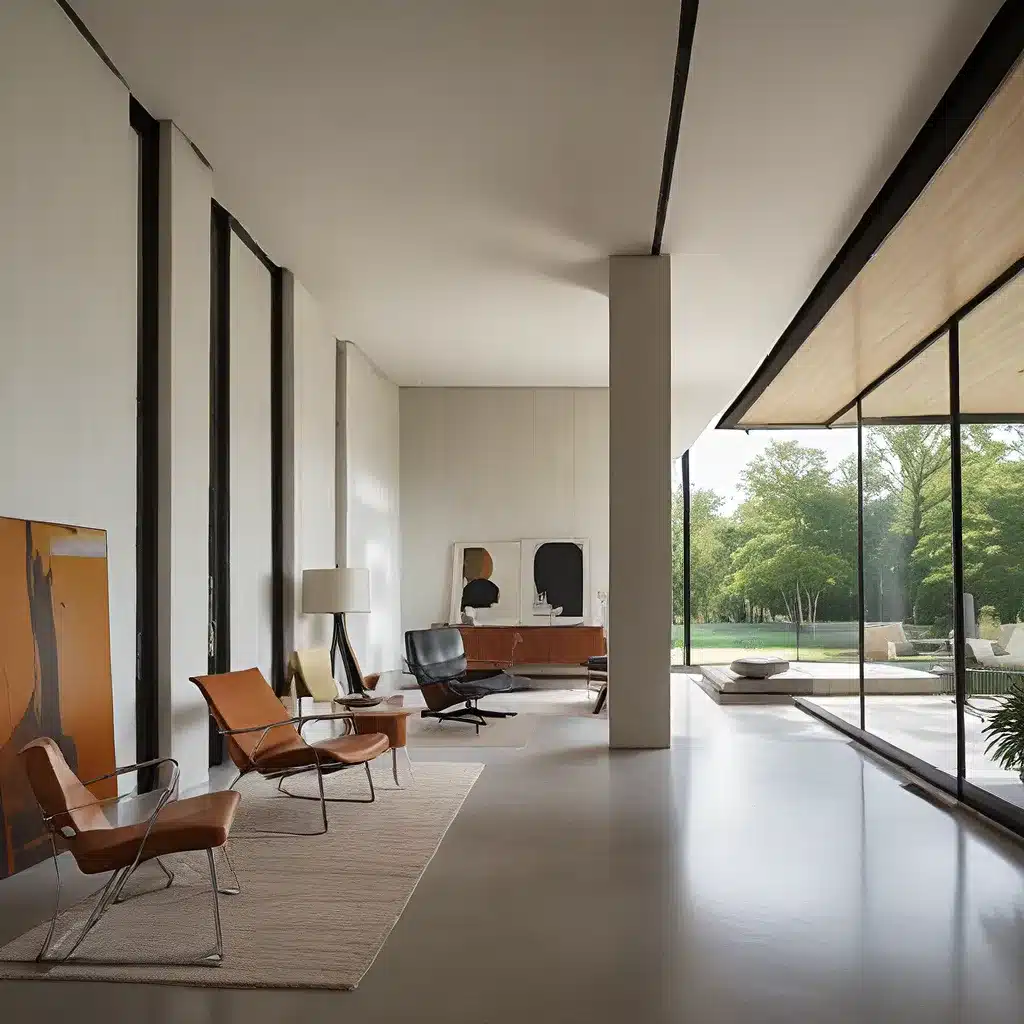
In the realm of interior design, the Modernist movement has long captured the imagination of design enthusiasts and homeowners alike. Characterized by its unwavering commitment to clean lines, functional aesthetics, and a harmonious integration with the natural world, Modernist design has left an indelible mark on the way we conceive and experience our living spaces.
The Essence of Modernist Design
At the heart of Modernist architecture lies the principle of form follows function, a mantra that has reverberated through the design community for decades. This philosophy dictates that the shape and appearance of a building or interior should be a direct result of its intended purpose and use. Gone are the days of excessive ornamentation and superficial embellishments; Modernist designers instead embrace a minimalist approach, allowing the inherent beauty of materials and the purity of design to take center stage.
Minimalism, a cornerstone of the Modernist movement, celebrates the clarity and simplicity that permeate architectural spaces. By stripping away unnecessary elements and distractions, Modernist designers create environments that exude a sense of serenity and visual harmony. The elimination of clutter in favor of open, uncluttered spaces allows the eye to focus on the essential and appreciate the inherent beauty of each design component.
Modernist Materials and Structural Innovation
The Modernist aesthetic is not merely a visual representation; it is a testament to the innovative use of materials and the advancement of structural engineering. The advent of steel, glass, and concrete during the 20th century revolutionized the construction industry, enabling architects to push the boundaries of what was previously considered possible.
Reinforced concrete and steel frames liberated Modernist designers from the constraints of load-bearing walls, allowing them to experiment with open floor plans, cantilevered structures, and expansive glass facades. These technological advancements not only enhanced the functional capabilities of buildings but also contributed to the visual elegance that has become synonymous with Modernist design.
Embracing Nature and Sustainability
Modernist architecture is not merely concerned with the built environment; it also seeks to establish a harmonious relationship with the natural world. Modernist designers often integrate outdoor spaces and abundant natural light into their projects, blurring the boundaries between interior and exterior. This biophilic approach emphasizes the importance of connecting with nature and promoting the well-being of building occupants.
Moreover, the Modernist ethos has evolved to encompass the principles of sustainability. Contemporary Modernist designers are increasingly incorporating eco-friendly materials, energy-efficient systems, and passive design strategies into their projects, ensuring that the buildings of today not only embody the timeless elegance of Modernism but also contribute to a more sustainable future.
Iconic Modernist Masterpieces
The Modernist design philosophy has inspired the creation of some of the most iconic and celebrated structures in the world. From the sleek skyscrapers of New York City to the serene residential havens nestled in the hills, Modernist architecture has left an indelible mark on the global built environment.
The Bauhaus School in Germany, designed by architect Walter Gropius, is widely regarded as a touchstone of Modernist design. Its clean lines, functional layout, and harmonious integration with the surrounding landscape have inspired generations of architects and designers.
Across the Atlantic, the Farnsworth House by Mies van der Rohe stands as a shining example of Modernist residential design. The glass-enclosed pavilion nestled in the Illinois countryside epitomizes the Modernist ideal of seamless integration with nature, creating a serene and contemplative living experience.
In the realm of commercial architecture, the Seagram Building in New York City, designed by Mies van der Rohe, is hailed as a pinnacle of Modernist design. Its striking bronze-tinted glass facade and minimalist aesthetic have become iconic representations of the Modernist movement, influencing the design of countless skyscrapers around the world.
The Enduring Appeal of Modernism
The enduring appeal of Modernist design can be attributed to its timeless elegance, functional excellence, and harmonious integration with the natural world. As the demands of contemporary living continue to evolve, the principles of Modernism remain relevant and resonant, inspiring designers to create spaces that are both aesthetically captivating and deeply functional.
Interior designers who embrace the Modernist philosophy often curate spaces that exude a sense of serenity and tranquility, allowing the inherent beauty of materials and the simplicity of design to take center stage. By incorporating clean lines, minimalist furnishings, and ample natural light, they create environments that are both visually striking and genuinely conducive to modern living.
Moreover, the sustainability inherent in Modernist design has become increasingly crucial in today’s climate-conscious world. The emphasis on energy-efficient systems, the use of eco-friendly materials, and the seamless integration with nature make Modernist architecture a compelling choice for those seeking to reduce their environmental impact while elevating their living experience.
In conclusion, the Modernist movement in architecture and interior design continues to captivate and inspire design enthusiasts and homeowners alike. By embracing clean lines, functional aesthetics, and a harmonious relationship with nature, Modernist designers have created a timeless and enduring aesthetic that continues to shape the way we envision and experience our built environments. As we navigate the ever-evolving landscape of design, the principles of Modernism stand as a testament to the power of simplicity, the beauty of function, and the importance of creating spaces that enrich the human experience.

